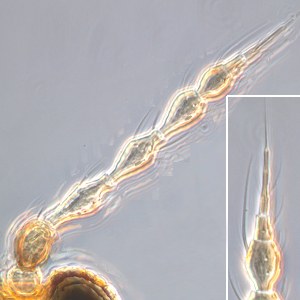Figures
Fig. 1: Antenna (inset: VI.-VIII. antennal segment)
Fig. 2: Head dorsal with ocellar triangle
Fig. 3: Pronotum
Fig. 4: Meso- and metanotum
Fig. 5: Fore- and hindwing
Fig. 6: Tergites II and III lateral
Fig. 7: Tergites II and III
Fig. 8: Tergites VIII-X
ITS-RFLP gel patterns (1&8 ladder, 2 PCR-product, 3 RSAI, 4 HaeIII, 5 MspI, 6
HinfI, 7 AluI)
Fig. 9: Primer pair O1/18J
Fig. 10: Primer pair P1/28Z
Taxonomic Information
Species:
Hercinothrips bicinctus (Bagnall, 1919)
Synonyms:
Heliothrips bifasiatipennis Girault,
1961
Heliothrips bifasciipennis Girault, 1926
Heliothrips femoralis Reuter, 1921
Heliothrips bicinctus Bagnall, 1919
Common name:
Smilax thrips
Present taxonomic position:
Family: Thripidae
Stephens, 1829
Subfamily: Panchaetothripinae Bagnall, 1912
Genus: Hercinothrips Bagnall, 1932
Species Recognition
General information about the genus Hercinothrips:The are nine members in this genus all of which are dark brown, characters that define the Hercinothrips genus include with eight antennal segments, segments III and IV having a simple sense cones, and the forewings are banded and narrow. These are the only members in the Helio-Calio-Hercinothrips group, subfamily Heliothripini, which maintain a two-segmented tarsus.
Typical character states of Hercinothrips bicinctus:
Body color
Mainly brown
Antennae
Number of antennal segments: 8
Segment IV - forked sensorium: extending to a point at least 30% distal to base of segment V
Segments III & IV sensoria: emergent and forked
Terminal antennal segments: very long, needle like
Head:
Head shape between compound eyes: not prolonged
Sculptured reticles on head and pronotum: with no internal markings
Surface of head, pronotum and fore legs: with strong reticulate sculpture, but sometimes irregular
Head posteriorly: constricted
Prothorax
Number of pairs of elongate pronotal setae: 0-3
Number of pairs of elongate posteroangular pronotal setae: 0
Pronotum: with complex sculpture - with faint sculpture
Prosternal basantra: absent - present
Pronotum shape: rectangular
Sculptur of pronotum: without transverse striate sculpture
Mesothorax
Mesothoracic endofurca: without median spinula
Metathorax
Metanotum: without campaniform sensilla
Metanotum major sclerite: with two major sclerites, metascutum and metascutellum
Metanotum median area: with at least some equiangular reticulation
Metanotum sculpture: without dominant sculptured triangle medially
Metathoracic endofurca: elongate and Y-shaped
Wings
Wings: present and more than half as long as abdomen
First vein of forewing: close to or fused to costal vein
Forewing anterior margin: with setae and cilia but cilia longer than setae
Forewing color: alternating bands of dark and light
Forewing costal setae at middle of wing: longer than median width of wing
Forewing first vein setal row: complete, with setae closely and uniformly spaced
Forewing posterior margin cilia: undulated near apex
Forewing second vein setal row: complete, with setae closely and uniformly spaced
Forewing surface: not reticulate
Forewings: with veins, setae and microtrichia
Legs
Mid and hind tarsi: with two segments
Abdomen:
Abdominal segment X: never tubular, longitudinally incomplete ventrally in both sexes
Abdominal tergites: without curved wing-retaining setae
Abdominal tergites IV & V median setal pair: much shorter than distance between their bases
Setae on abdominal tergite X: slender
Tergite VIII posteromarginal comb of microtrichia: present laterally, incomplete medially
Biology
Life history:
As with other thrips species the life
cycle from egg to adult is dependent on temperature. The full cycle can take
about 15 days (Lewis, 1973) to over a month and adults may live for more
than one month producing several generations in one year depending on seasonal
weather. With greenhouse temperatures the developmental time from egg to
adult can decrease to about one week.
Host plants:
Greenhouse plants, Banana
Vector capacity:
None identified
Current known distribution:
Africa, Australia, New Zealand, Europe
(originally from Africa and established in the tropics and subtropics where
greenhouse plants are grown).
Additional notes:
This species has been introduced throughout
the world on greenhouse plants and is a considerable pest.
Bibliography
Bailey, SF (1957): The
thrips of California Part I: Suborder Terebrantia. Bulletin of the
California Insect Survey 4, no. 5: 143-220.
Lewis, T (1973): Thrips their biology, ecology and
economic importance. Academic Press Inc., London Ltd. 349 pp.
Martin,
NA (1999): Arthropods and molluscs associated with poroporo (Solanum
aviculare and S. laciniatum): an annotated species list. - Journal
of the Royal Society of New Zealand 29 (1): 65-76.
Moritz G, Morris DC, Mound LA (2001): ThripsID -
Pest thrips of the world. ACIAR
and CSIRO Publishing Collingwood, Victoria, Australia, CDROM ISBN 1
86320 296 X.
Moritz G, Mound LA, Morris DC, Goldarazena A (2004): Pest
thrips of the world - an identification and information system using molecular
and microscopial methods. CBIT, University of Queensland,CDROM ISBN 1-86499-781-8.
Mound, LA & Kibby, G (1998): Thysanoptera: An identification guide, (2nd
edition). CAB International, Wallingford and New York, 70pp.
Mound, LA & Marullo, R (1996): The
thrips of Central and South America: An Introduction (Insecta: Thysanoptera).
Associated Publishers, Gainesville.
Stannard, LJ (1968): The thrips, or Thysanoptera, of Illinois.
Illinois Natural History Survey Bulletin 29: 215-552.
Wilson, TH (1975): A monograph of the subfamily Panchaetothripinae
(Thysanoptera: Thripidae). Memoirs of the American Entomological Institute 23:
1-354.
Links:
Mound, LA (2005): Thysanoptera (Thrips) of the World
- A Checklist. http://www.ento.csiro.au/thysanoptera/worldthrips.html











